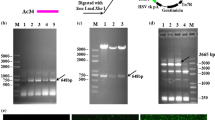Abstract
The baculovirus Autographa californica multiple nucleopolyhedrovirus (AcMNPV) possesses a gene, ac-pcna or ac49, which encodes a protein with similarity to proliferating cell nuclear antigen (PCNA). Homologs of this gene code for DNA polymerase processivity factors and are essential in the DNA replication systems. But the function of ac-pcna still remains unclear. To define the function of Ac-pcna in AcMNPV and Sf-pcna in host Sf9 cells, Bac-to-Bac baculovirus expression system was used to generate two recombinant baculoviruses: AcMNPV-Ac-pcna-EGFP and AcMNPV-Sf-pcna-EGFP. Results indicated that AcMNPV-mediated overexpression of Ac-PCNA and Sf-PCNA could stimulate replication of AcMNPV genome in the host Sf9 cells. Meanwhile, either AcMNPV-Ac-pcna-EGFP or AcMNPV-Sf-pcna-EGFP had a significant stimulating effect on Sf9 genome replication during infection. We also found that Ac-PCNA and Sf-PCNA could promote the production of budded virus. Ac-PCNA could improve the transcription level of ie2 gene dramatically and further improved the transcription of late gene, for example 38 K and vp39, at 12 h p.i.. Moreover, insecticidal potency test showed that the larvae of Beet armyworm in the AcMNPV-Ac-pcna-EGFP and AcMNPV-Sf-pcna-EGFP groups had a higher mortality rate (83.33 and 91.67%), a lower pupation rate (16.67 and 8.33%), and a lower emergence rate (6.67 and 3.33%), compared with those in AcMNPV-EGFP group. The function of Ac-PCNA and Sf-PCNA was confirmed in this study, which provided the theoretical foundation for using and modifying AcMNPV.







Similar content being viewed by others
References
Peng K, Wu M, Deng F, Song J, Dong C, Wang H, Hu Z (2010) Identification of protein-protein interactions of the occlusion-derived virus-associated proteins of Helicoverpa armigera nucleopolyhedrovirus. J Gen Virol 91:659–670
Ayres MD, Howard SC, Kuzio J, Lopez-Ferber M, Possee RD (1994) The complete DNA sequence of Autographa californica nuclear polyhedrosis virus. Virology 202:586–605
Takahashi T, Caviness VS Jr (1993) PCNA-binding to DNA at the G1/S transition in proliferating cells of the developing cerebral wall. J Neurocytol 22:1096–1102
Maga G, Hubscher U (2003) Proliferating cell nuclear antigen (PCNA): a dancer with many partners. J Cell Sci 116:3051–3060
Xing G, Kirouac K, Shin YJ, Bell SD, Ling H (2009) Structural insight into recruitment of translesion DNA polymerase Dpo4 to sliding clamp PCNA. Mol Microbiol 71:678–691
De Biasio A, Blanco FJ (2013) Proliferating cell nuclear antigen structure and interactions: too many partners for one dancer? Adv Protein Chem Struct Biol 91:1–36
Krishna TS, Kong XP, Gary S, Burgers PM, Kuriyan J (1994) Crystal structure of the eukaryotic DNA polymerase processivity factor PCNA. Cell 79:1233–1243
Herniou EA, Olszewski JA, Cory JS, O’Reilly DR (2003) The genome sequence and evolution of baculoviruses. Annu Rev Entomol 48:211–234
Wei L, Cao L, Miao Y, Wu S, Xu S, Wang R, Du J, Liang A, Fu Y (2017) Transcriptome analysis of Spodoptera frugiperda 9 (Sf9) cells infected with baculovirus, AcMNPV or AcMNPV-BmK IT. Biotechnol Lett 39:1129–1139
Mehrabadi M, Hussain M, Matindoost L, Asgari S (2015) The baculovirus antiapoptotic p35 protein functions as an inhibitor of the host RNA interference antiviral response. J Virol 89:8182–8192
Wu C, Wang S (2012) A pH-sensitive heparin-binding sequence from Baculovirus gp64 protein is important for binding to mammalian cells but not to Sf9 insect cells. J Virol 86:484–491
Carrasco-Miranda JS, Lopez-Zavala AA, Arvizu-Flores AA, Garcia-Orozco KD, Stojanoff V, Rudiño-Piñera E, Brieba LG, Sotelo-Mundo RR (2014) Crystal structure of the shrimp proliferating cell nuclear antigen: structural complementarity with WSSV DNA polymerase PIP-box. PLoS ONE 9:e94369
Crawford AM, Miller LK (1988) Characterization of an early gene accelerating expression of late genes of the baculovirus Autographa californica nuclear polyhedrosis virus. Virol. 62:2773–2781
Li L, Harwood SH, Rohrmann GF (1999) Identification of additional genes that influence baculovirus late gene expression. Virology 255:9–19
Lu A, Miller LK (1995) The roles of eighteen baculovirus late expression factor genes in transcription and DNA replication. J Virol 69:975–982
Carson DD, Guarino LA, Summers MD (1988) Functional mapping of an AcNPV immediately early gene which augments expression of the IE-1 trans-activated 39 K gene. Virology 162:444–451
Acknowledgements
This project was supported by grants from ‘National Natural Science Foundation of China (No.31272100 and 31372199)’, ‘Natural Science Foundation of Shanxi Province (No.2014011038-1)’.
Author information
Authors and Affiliations
Corresponding author
Ethics declarations
Conflict of interest
The authors state that they have no conflict of interest.
Electronic supplementary material
Below is the link to the electronic supplementary material.
Supplementary Table 1
Sequence of primers used to amplify Ac-pcna, Sf-pcna, hr3, hsp90 (DOC 26 kb)
Supplementary Table 2
Sequence of primers used to amplify β-actin, 38K, vp39, ie2 in qPCR (DOC 27 kb)
Supplementary Table 3
Average weight of Beet armyworm larvae (g) (DOC 35 kb)
Supplementary Table 4
Mortality rate analysis of Beet armyworm larvae (DOC 45 kb)
Supplementary Table 5
Pupation rate analysis of Beet armyworm larvae (%) (DOC 33 kb)
Supplementary Table 6
Emergence rate analysis of Beet armyworm larvae (%) (DOC 33 kb)
Rights and permissions
About this article
Cite this article
Fu, Y., Wang, R. & Liang, A. Function analysis of Ac-PCNA and Sf-PCNA during the Autographa californica multiple nucleopolyhedrovirus infection process. Mol Cell Biochem 443, 57–68 (2018). https://doi.org/10.1007/s11010-017-3210-y
Received:
Accepted:
Published:
Issue Date:
DOI: https://doi.org/10.1007/s11010-017-3210-y




